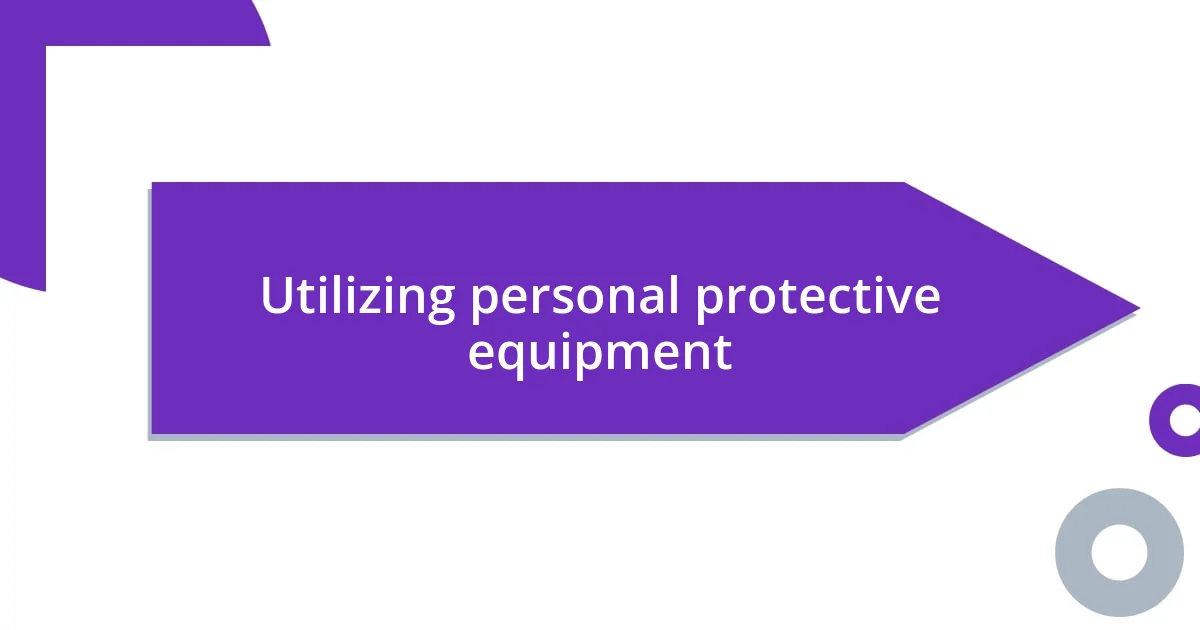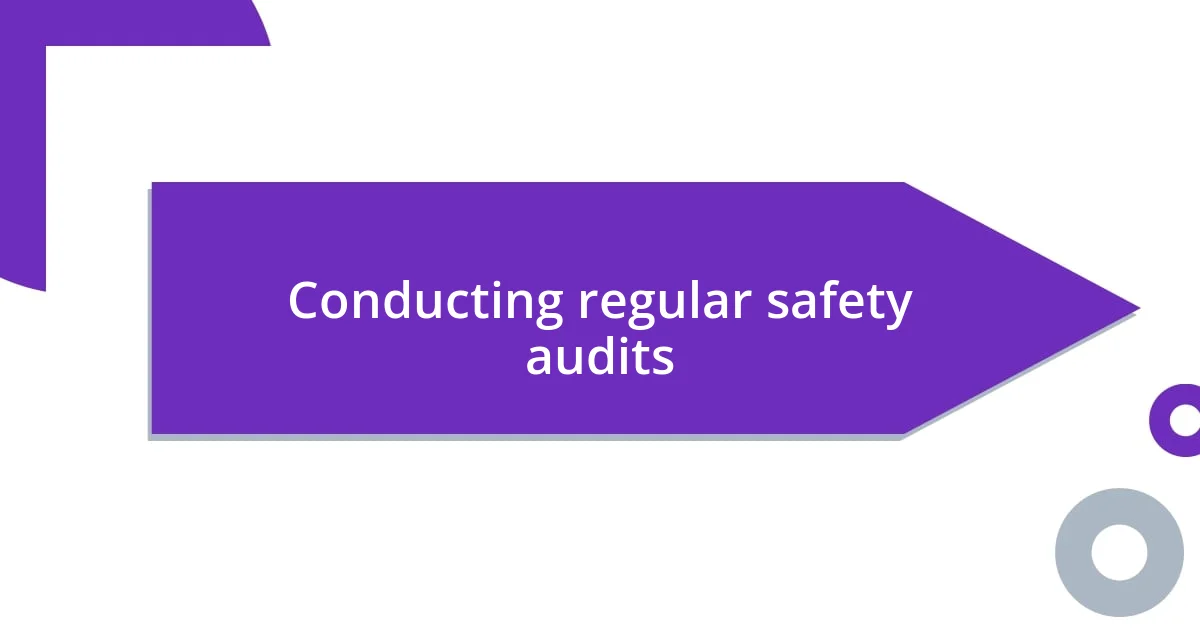Key takeaways:
- Comprehensive safety training and open communication enhance workplace safety and foster a culture of vigilance among team members.
- Regular hazard assessments, including identifying slips, trips, and equipment issues, are crucial in maintaining a secure construction environment.
- Conducting routine safety audits and maintaining a “safety buddy” system promote accountability and proactive identification of risks, ensuring continuous site safety improvements.

Understanding contractor safety measures
Understanding contractor safety measures is crucial in any project. When I think back to a time when we overlooked some safety protocols, I remember the palpable tension on-site. It’s hard to focus on the work when there’s that nagging feeling in the back of your head, isn’t it? That’s why developing a clear understanding of safety measures can transform a site from a potential stressor into a haven for productivity.
One of the most effective safety measures I’ve encountered is comprehensive training for everyone involved. Once, during a safety meeting, an experienced contractor shared his close call with a hazardous material due to a lack of proper training. Listening to his story made me realize that knowledge not only saves lives but fosters a culture of safety. What if everyone took the time to educate themselves on these risks? Wouldn’t that make a significant difference in outcomes?
Additionally, having an open line of communication regarding safety protocols is paramount. I recall a project where daily check-ins on safety measures became embedded in our routine. This practice not only kept everyone informed but also encouraged team members to voice concerns without hesitation. Isn’t it reassuring to know that every person has the power to contribute to a safer workplace? Understanding and implementing these contractor safety measures creates an environment where everyone feels valued and protected.

Identifying common safety hazards
Identifying common safety hazards on a construction site is essential to creating a secure environment. I still remember the first time I encountered an electrical hazard while working on a project. The sheer shock of seeing a frayed wire dangling just a few feet away from where we were setting up the equipment served as a wake-up call. It made me realize how vital it is to continually assess our surroundings for potential dangers, as even seemingly minor issues can escalate quickly into serious problems.
A hazard often overlooked is the risk of slips and trips. I once witnessed a coworker fall because we weren’t diligent about cleaning up spills promptly. The cringe I felt watching him hit the ground was a painful reminder that something as simple as a wet surface could lead to injury. So it’s essential to foster a culture of vigilance, where everyone feels responsible for keeping the area clear and safe, even during busy moments.
When evaluating hazards, it’s also crucial to recognize equipment-related issues. I recall a time when our team noticed excessive wear on a piece of machinery during a routine check. Instead of dismissing it as a minor issue, we took the time to address it proactively, preventing potential breakdowns and accidents. This experience taught me the importance of regular inspections and open discussions about safety concerns, ensuring everyone is continuously aware of the risks at hand.
| Common Safety Hazard | Personal Experience |
|---|---|
| Electrical Hazards | Encountered a frayed wire on-site that led to immediate safety protocol review. |
| Slips and Trips | Witnessed a coworker fall due to a spilled substance; reinforced the need for quick clean-up. |
| Equipment Wear | Identified excessive wear in machinery during checks, preventing future accidents. |

Implementing effective safety training
Implementing effective safety training can make all the difference on a job site. I vividly recall a particular training session where, instead of slideshows, we role-played emergency scenarios. The hands-on experience not only engaged everyone but created a tangible sense of urgency. It was eye-opening to see how quickly fear and confusion could set in if we weren’t prepared. Safety training needs to be more than just a checkbox; it should resonate in a way that sticks with individuals long after the session ends.
In my experience, tailoring training to the specific risks of the site has proven invaluable. Here’s how to enhance safety training effectively:
- Engage through interactive methods: Implement role-playing activities for real-world scenarios.
- Customize content: Identify hazards specific to your project and focus on those in training.
- Encourage feedback: Create a safe space for team members to share concerns and suggestions.
- Use visuals: Incorporate videos and diagrams to illustrate best practices clearly.
- Regular refreshers: Schedule periodic training updates to keep everyone sharp and aware of new protocols.
Training doesn’t just inform; it can empower. When everyone feels equipped to tackle potential hazards, the overall atmosphere on-site shifts dramatically.

Utilizing personal protective equipment
Using personal protective equipment (PPE) is a critical component of staying safe on a construction site. I still vividly remember my first day on a project where everyone donned their hard hats, gloves, and eye protection. Watching that collective effort instilled a sense of responsibility in me; it became clear that wearing PPE was not only about complying with rules—it was about looking out for each other.
There was a time when I underestimated the importance of proper footwear. I showed up to work in my usual steel-toed boots but wasn’t wearing any non-slip soles. One rainy afternoon, while carrying materials, I lost my footing on a slick surface and almost toppled over. That close call taught me that wearing the right gear can be a game-changer, ensuring that you can navigate hazardous conditions confidently.
What about those times when the weather turns unexpectedly? I had a day when the wind whipped through the site, and I noticed that some colleagues had neglected to use their harnesses while working on elevated platforms. I couldn’t help but feel a pit in my stomach watching them work precariously; it emphasized the necessity of always wearing fall protection equipment, as it ensures that we have a safety net, literally and figuratively. PPE isn’t just gear—it’s what stands between us and potential harm, and it deserves our priority every single day.

Establishing safety communication protocols
Establishing clear communication protocols for safety on the job site can truly shape the culture of safety itself. I remember one project where we implemented daily safety huddles. Each morning, we gathered for just ten minutes to discuss potential hazards and share any near-misses from the day before. Those quick meetings not only kept safety top of mind, but they also fostered a camaraderie among our team, as everyone felt comfortable voicing their concerns.
One strategy that proved effective was adopting a “safety buddy” system. Partnering up created an atmosphere of accountability. I found that when someone had another person looking out for them, they were more cautious and less likely to skip safety steps. Have you ever had that moment where you felt someone was watching your back? It makes a world of difference when you know someone else is equally invested in everyone’s wellbeing.
Maintaining an open line of communication about safety protocols has also been crucial. During one project, I discovered that our incident reporting system was underutilized. To tackle this, I shared my own experiences and emphasized that reporting hazards isn’t about assigning blame but about learning and improving. After I opened up, more team members felt encouraged to share their insights, and together we began to create a genuinely safer work environment. When everyone feels heard, safety becomes a collaborative journey rather than a solitary task.

Conducting regular safety audits
Conducting regular safety audits is something I’ve come to view as an essential practice on any construction site. I recall a project where we had a quarterly audit that not only checked for compliance but also created a platform for open discussion. It was during one of these audits that a colleague discovered a potential hazard in our scaffolding setup, which was a sobering reminder that safety isn’t just about following rules—it’s about actively engaging with our surroundings.
There’s a profound sense of relief that washes over me when we find and fix safety issues during audits. I’ll never forget a time when a thorough inspection revealed some frayed cables in our lifting equipment. Seeing those worn-out cables, I felt a surge of gratitude that we had caught that before anyone got hurt. It underscores the idea that safety audits are more than checks on a checklist; they are proactive measures that genuinely protect lives.
Have you ever considered what a nonchalant attitude towards audits could lead to? I often think back to when I doubted the necessity of bringing in external auditors. It seemed excessive until they uncovered several overlooked safety gaps. That experience taught me an invaluable lesson—regular audits and inspections lead to greater accountability and awareness. They remind us that safety isn’t just a box to tick but an ongoing commitment to foster a culture where everyone feels empowered to speak up, identify risks, and ensure a safe working environment for all.














